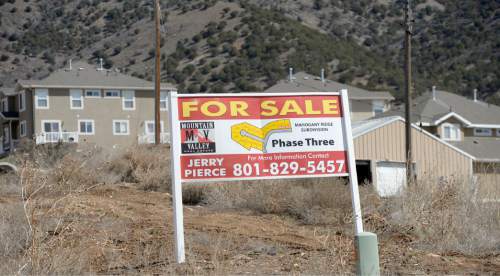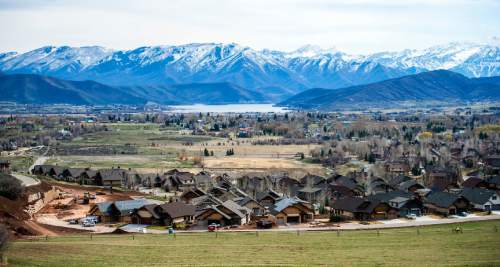This is an archived article that was published on sltrib.com in 2015, and information in the article may be outdated. It is provided only for personal research purposes and may not be reprinted.
St. George, Heber City, Vernal and Morgan County ranked among the nation's fastest-growing areas last year — even though increases there and statewide remain relatively slow compared with recent boom times.
The U.S. Census released estimates Thursday showing that St. George was the nation's fifth-fastest growing metropolitan area. Its population jumped by 2.9 percent between 2013 and 2014 to 151,948 residents.
For "micropolitan" areas — between 10,000 and 50,000 in population — Heber City ranked No. 3 in the nation with 4.3 percent growth. Vernal was No. 5 at 3.3 percent.
And for counties with populations greater than 10,000, Wasatch County — home of Heber City — ranked No. 8 nationally, also with 4.3 percent growth. Morgan County was No. 10 with 4 percent.
The Census Bureau estimates for counties and metropolitan and micropolitan areas followed last December's estimates for states, which reported Utah's overall 2014 population at 2.94 million, up 1.4 percent from the previous year.
"It is slow growth by Utah standards" in most areas statewide, even if some of them are leading the nation, said Pam Perlich, senior research economist at the University of Utah.
"In the period since we've been in the Great Recession," she said, "you see the population-growth numbers way down" compared to the 1990s and years before the crash.
To illustrate, St. George was coincidentally ranked No. 5 last year and in 2006. But in 2006, its growth rate was 7.7 percent — more than double the latest 2.9 percent bump.
Utah's birthrates have been lower in the recent tighter economic times, Perlich noted, although they now appear to be rebounding. And net in-migration has been far lower.
Still, some areas are flourishing.
The Heber City area grew the fastest, up 4.3 percent to 27,714 people.
"It's a great place to live," said Wasatch County Manager Mike Davis. "It's beautiful. It has a lot of recreation opportunities for outdoor enthusiasts: trails, biking, hiking, horses, fishing, hunting."
He said a main reason for its growth is that it offers country living, but still allows residents to commute to work in nearby Utah or Salt Lake counties. "We're very close, so we've become a commuter community."
Bill Cobabe, director of planning and development in Morgan County, sees similar reasons for its relatively fast growth. Its population now is 10,608.
"It's the quality of life that attracts people the most to Morgan County. It's kind of a rural setting, but it's also close to all the amenities people are looking for like shopping and entertainment" down the canyon in Ogden. "We don't necessarily have those amenities and jobs here, but we're working on it."
St. George Mayor Jon Pike said proximity to national parks such as Zion and Grand Canyon has made St. George famous internationally. "A lot of people say, 'We love it here.' Some come back to live here as well as play here."
An expanded economic base with more manufacturing, more jet service and an expanding Dixie State University are bringing more people, he said. "It's a recipe for good sustained growth. We're not necessarily looking for the kind of growth we had 10 years ago, which frankly was difficult to sustain and manage."
The Vernal area, meanwhile, may have seen big growth in 2013-14, reaching a population of 36,867 ,"but it has stopped now," said City Manager Ken Bassett.
The area depends on the oil and natural gas industries and when crude prices plummeted this year, "we had a lot of layoffs," Bassett said.
"But it's still hard to turn left on Main Street," with congestion and crowding from recent growth, said Sen. Kevin Van Tassell, R-Vernal, who is also a banker in the area.
He said he has not seen many people leave, and some companies still plan to expand despite recent oil-price drops. Van Tassell said the only noticeable drops are in temporary workers who had lived in hotels. "The more permanent people seem to be staying."
In some other key Utah areas, population in the Salt Lake City metropolitan area was up 1 percent to 1.15 million; the Provo-Orem metro area was up 1.6 percent to 571,460; and the Ogden-Clearfield metro area reached a population of 632,293, also up 1.6 percent.
Twenty counties in Utah gained population in 2014, one (Beaver) stayed the same and eight lost residents, according to Census estimates. Those that lost population included: Piute, down 2.6 percent; Carbon, 1.3 percent; Daggett, 1.2 percent; Emery and Garfield, 0.8 percent; Wayne and Sevier, 0.3 percent; and Millard, 0.2 percent.
Perlich questions the Census estimates for some counties with large university student populations, such as Utah and Cache counties.
While the Census figures that Utah County had modest overall growth of 1.6 percent, mostly because of births, Perlich notes the Census estimates it actually lost 840 people to outmigration. She doubts that is accurate because of heavy construction and apparent growth in northern Utah County.
The Census relies heavily on Internal Revenue Service tax returns to estimate where people are moving and, students often do not file tax returns when they first go to school, but do when they graduate, Perlich said. "So they catch them leaving, but not coming."
Utah County, of course, is home to Utah Valley University and LDS Church-owned Brigham Young University.
Similarly, the Census also figured Cache County, home of Utah State University, lost 893 people during the year to outmigration. Salt Lake County, home to the University of Utah, Westminster College and Salt Lake Community College, lost an estimated 673 people to outmigration. Both counties still had overall population increases because of births. —
Utah areas that were leaders in national growth between 2013 and 2014
Metropolitan areas • St. George ranks No. 5 in the nation with 2.9 percent growth.
Micropolitan areas • Heber City ranks No. 3 nationally at 4.3 percent growth, and Vernal is No.5 at 3.3 percent for areas with populations between 10,000 and 49,999.
Counties • Wasatch County ranks No. 8 nationally at 4.3 percent growth, and Morgan County ranks No. 10 with 4 percent for counties with populations greater than 10,000.









